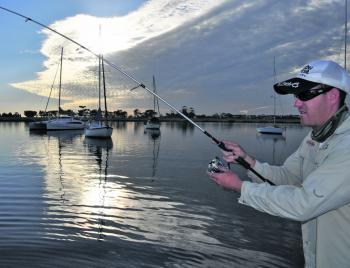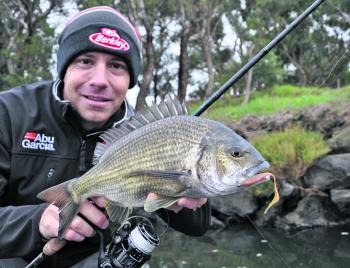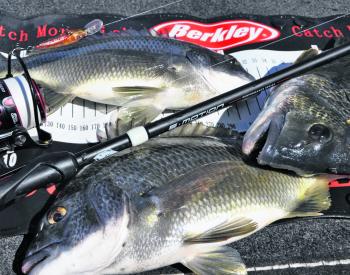As temperatures gradually decline both above and below the surface, one would expect the fishing to also be on the slide, but that certainly isn’t the case across the western shores of Port Phillip. Indeed, the inner reefs are alive with action in the form of King George whiting, pinkie snapper and Australian salmon. The local rivers are a hot topic, with some serious southern black bream and school mulloway on offer in each of the major tributaries.
It’s not only the rivers that produce bream. They can also be found schooling tightly among the jetty pylons within Corio Bay. These fish are most likely residents of the nearby Hovells Creeek, where the entrance, also known as Limeburners or Grammar School Lagoon, holds some solid specimens. Lightly weighted wriggly- tail soft plastics, such as grubs or worm imitations, are a good option for those fishing on the drift from a small tinnie or pedal powered kayak. Likewise, twitching a shallow running bibbed minnow along the yacht moorings should bring a few undone. Scale back the breaking strain of your leader material to 3-4lb fluorocarbon to increase your chances, particularly when the water is at its clearest on the top of the tide.
Over at Point Wilson, there’s a real mixed bag on offer in the shallows. King George whiting are the primary target species in this area and the stretch from Point Wilson pier through to Kirks Point offers up some impressive bags. Just prior to setting off to Portland for a stint on the bluefin tuna, Jason Farrugia of Magnet Fishing Charters mentioned he regularly boated whiting to 45cm for his clients. These fish have responded well to baits of pipi and tenderised squid strips in 2-5m of water, alongside some hefty flathead. Those fishing on the drift with soft plastics are also picking up some great eating-size flathead, as well as pinkie snapper to 55cm in among numbers of juveniles. To top it off, Australian salmon have been popping up regularly, chewing their way through the abundant bait congregating in this area. Soft plastics and small metal lures cranked at high speed close to the surface generally results in a hook up when the sambos are on the job. Working the mobile berley trail, created by a marauding school of salmon, can also produce a bonus snapper or any number of scavenger species mopping up the scraps below.
Speaking of snapper, Michael Felsovary from Hooked on Bait & Tackle says the 12-14m line straight out from Werrribee South is well worth a look. Likewise, the outer anchorage at Point Cook has been productive with late season reds to 3kg, along with the odd larger specimen, responding well to pilchards and sauries.
Areas of shallow reef from Millers Road at Altona through to Point Gellibrand are expected to turn up plenty of pinkie snapper action this month. Fishing on the drift with soft plastics is a great way to cover ground relatively quickly. When you come across a fish or two, create a waypoint on the GPS and come back to fish it later. Once you’ve put in a number of sessions, you’ll soon start to piece together a pattern.
Bream and pinkie snapper should be on the go among the Williamstown yacht moorings at the entrance to the Yarra River this month. Small diving minnows and worm pattern soft plastics often bring these fish undone. Live crab cast among the jetty pylons is also a good option for the land-based crew.
Further upriver, pitching crab imitations and small vibe style lures at the bridge pylons either side of high water should see the hot bream bite continue this month. Similar action can be expected on the Maribyrnong River, where the resident bream are still active on the rocky edges and responding well to small diving minnows and worm or grub pattern soft plastics.
Finally, we should start to see a few more school mulloway through May. For anyone hoping to snare their first on a lure, it’s hard to go past a well rigged soft plastic, be it a paddle-tail or worm imitation. As the season progresses, small metal vibes also account for a slice of the action. Most mulloway react to a lure or plastic within the initial stages of the retrieve, either as the offering descends immediately after casting or within the first few hops up off the bottom. Hits are generally quite distinctive and can be recognised by a solid tick or bump that transfers through the rod tip as the lure is inhaled. Therefore, it is important to maintain a slight bow in the line as the lure descends – both after casting and in between imparting action on the lure. Anytime the line flicks or twitches strike firmly to set the hook and keep the pressure on at all times. Mulloway are experts at expelling hooks!
Reports and images are most welcome and may be submitted via email to --e-mail address hidden--
Reads: 1369
Brad Hodges gingerly applies the brakes to a super-charged bream among the yacht moorings at Limeburners Lagoon. The lead up to high tide, followed by the first two hours of the run-out offer the best chance of striking these fish in feeding mode.

Areas of shallow reef are expected to turn up plenty of pinkie snapper action this month.

Melbourne’s resident bream are still quite active along the rocky margins and respond well to small diving minnows and worm or grub pattern soft plastics, such as this Gulp 3” Nemesis.

The hot edge bite in the metropolitan rivers is likely to continue through early May, before gradually tapering off with the onset of cooler weather in the lead up to winter.

We should start to see a few more school mulloway in the metropolitan rivers this month.




